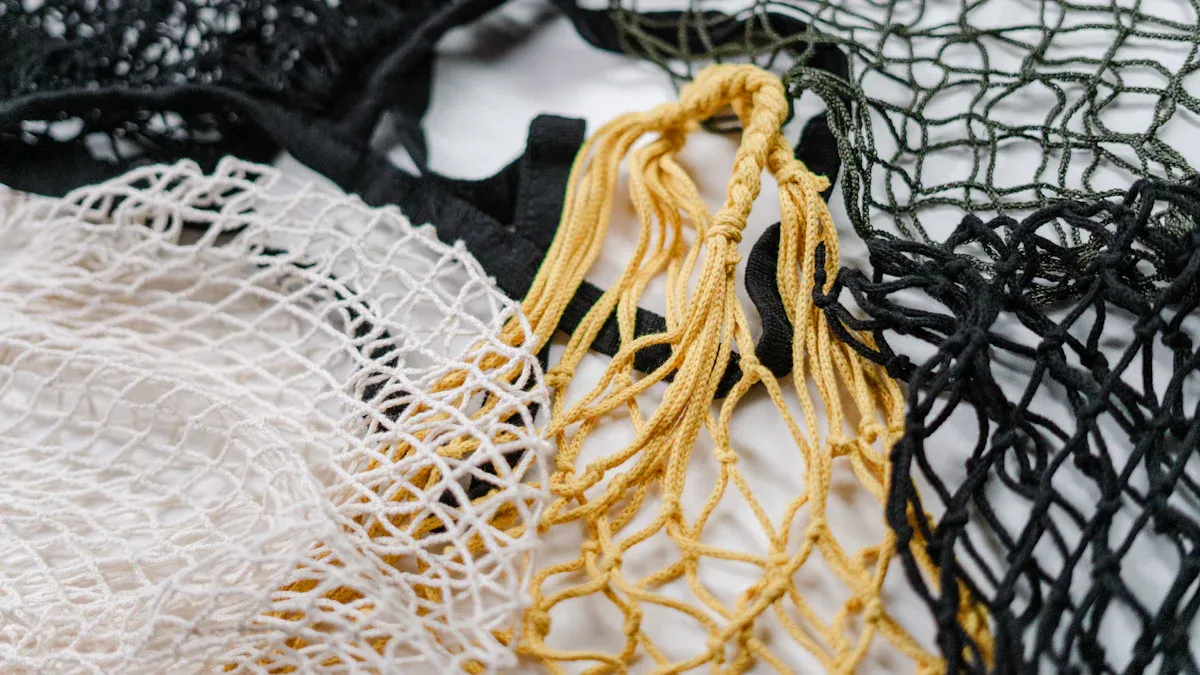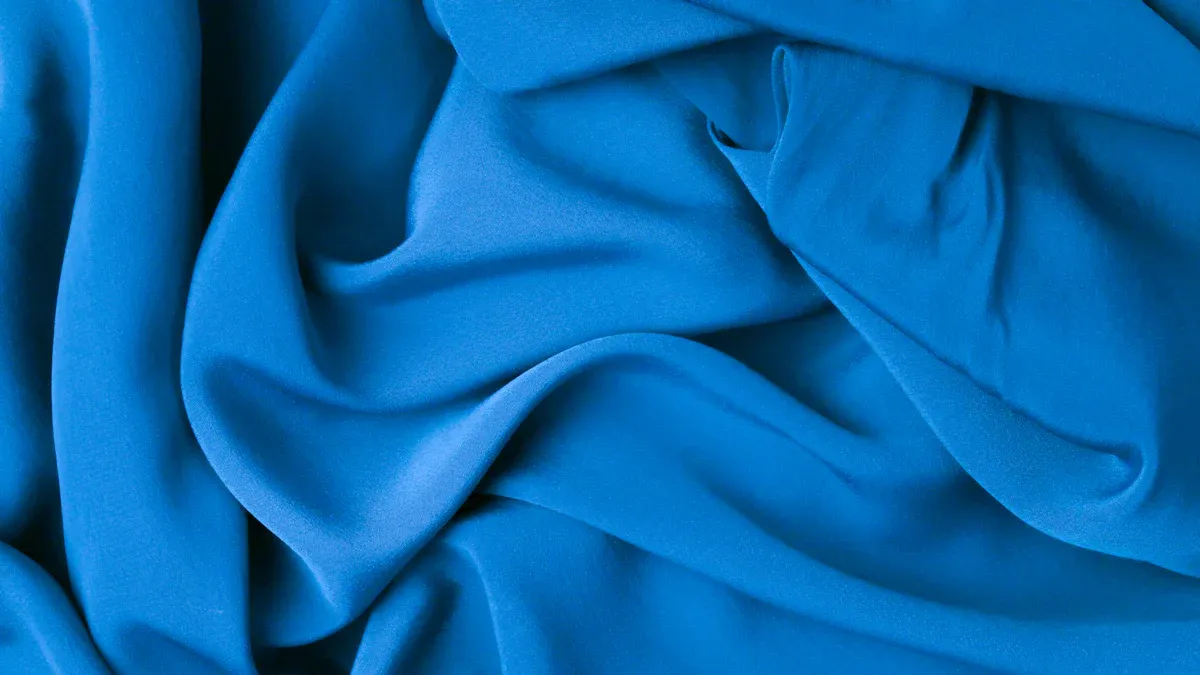
Costume satin fabric brings a sense of luxury and elegance to both stage and street. Designers value costume satin fabric for its signature sheen and smooth texture. Under lights, costume satin fabric reflects color and movement, making costumes stand out. People choose costume satin fabric for its comfort and durability in daily outfits. Costume satin fabric adapts easily to many styles, showing its versatile use. The luxury of costume satin fabric appeals to anyone who wants to add a special touch to their wardrobe.
Key Takeaways
- Costume satin fabric offers a smooth, shiny surface that adds elegance and luxury to costumes and daily clothes.
- Its excellent drape and movement make satin ideal for stage performances and comfortable everyday wear.
- Satin is durable, easy to care for, and comes in many vibrant colors, supporting creative designs and long-lasting use.
- Different satin types, like cotton and polyester blends, balance comfort, strength, and affordability for various needs.
- Proper washing and storage keep satin fabrics looking fresh and beautiful, extending their life and shine.
Understanding Costume Satin Fabric
Composition and Weave of Satin Fabric
Satin stands out because of its special weave. The satin weave uses four or more weft yarns that float over a warp yarn or the other way around. This creates a smooth, shiny surface on one side and a dull back. The weave pattern often has at least five threads, with the weft thread covering several warp threads. Satin fabric can use many fibers, such as silk, polyester, or cotton. Cotton satin fabric combines the softness of cotton with the shine of satin. The yarns in satin are twisted and spun with care, which adds to the fabric’s luster and drape. Finishing treatments like mercerization and calendering make the surface even smoother and shinier. Thread density in satin ranges from 85 to over 220 threads per square centimeter, which affects the quality and feel. Modern looms and digital design techniques help create satin with consistent results and new patterns.
Research on traditional costume design, such as Qin opera costumes, shows how digital tools like 3D pattern making and virtual stitching help designers simulate satin’s properties. These innovations keep the look and feel of satin while adding modern touches.
How Costume Satin Fabric Differs from Other Satin Types
Costume satin fabric has unique qualities that set it apart from other types of satin. Designers often choose it for its balance of shine, durability, and comfort. Costume satin fabric can use blends like cotton satin fabric or polyester to make it more affordable and easier to care for. Some satin types, such as crepe-back satin or duchess satin, have different weights and textures. Costume satin fabric often needs to look good under stage lights and hold up to frequent use. It offers a mix of flexibility, strength, and visual appeal that works well for costumes and daily wear.
| Satin Type | Composition | Performance Characteristics |
|---|---|---|
| Crepe-Back Satin | Silk, polyester, or rayon fibers | Medium weight; textured back; versatile; easier to sew |
| Stretch Satin | Polyester with elastane/spandex | Glossy; stretchy; fits body contours; comfortable |
| Duchess Satin | Silk or synthetic fibers | Heavy; structured; holds shape; ideal for formal wear |
| Charmeuse Satin | Silk, polyester, or rayon fibers | Lightweight; fluid drape; soft; glossy front; matte back |
| Traditional Silk Satin | Natural silk fibers | Soft; natural luster; breathable; delicate |
| Modern Synthetic Satin | Polyester, nylon, rayon | Durable; wrinkle-resistant; machine washable; affordable |
| Blended Satin | Silk-polyester, cotton-satin blend | Balanced cost, feel, and performance; cotton satin fabric is more breathable but less shiny |
Common Types and Examples, Including Suerte
Satin comes in many forms, each with its own uses. Costume satin fabric includes cotton satin fabric, which feels soft and looks shiny. Polyester satin is popular for costumes because it is strong and easy to clean. Cotton satin blend fabrics offer a mix of comfort and sheen. Suerte Textile produces a wide range of satin, including cotton satin fabric and blends. Their advanced machinery and digital printing allow for custom patterns and colors. Suerte’s satin uses include theater costumes, dresses, and accessories. The company’s quick response and design support make it a top choice for both stage and everyday satin applications.
- Common satin uses:
- Costumes for theater and dance
- Dresses, skirts, and blouses
- Accessories like scarves and linings
Satin’s wide range of applications makes it a favorite for designers and wearers alike.
Key Qualities of Costume Satin Fabric
Signature Sheen and Visual Appeal
Satin stands out for its elegant shine and smooth surface. Light reflects off satin, creating a glow that draws attention on stage and in daily life. Designers often choose satin for its ability to add luxury and elegance to garments. The surface of satin fabric feels soft and looks rich, making it a favorite for costumes and special outfits. Cotton satin fabric combines the softness of cotton with the glossy look of satin, giving both comfort and style. Many people notice the unique luster of satin in dresses, blouses, and accessories. This visual appeal helps satin garments look more expensive and refined. The elegant shine of satin fabric makes it a top choice for anyone who wants to stand out.
Note: Satin’s signature sheen comes from its special weave, which places more threads on the surface. This technique gives satin its smooth, light-catching finish.
Drape, Movement, and Performance
Satin fabric moves gracefully and drapes well on the body. Costume satin fabric flows smoothly, making it ideal for stage costumes and dancewear. The way satin hangs and moves adds drama and beauty to performances. Researchers have studied how satin drapes using advanced tools like the Cusick drapemeter and 3D drape models. These studies show that satin’s drape depends on factors such as intensity, severity, and shape symmetry. The modified drape coefficient (MDC) gives a better measure of how satin behaves when worn or moved. Virtual garment simulation software uses real satin data to show how costumes will look and move on stage. This helps designers create garments that look beautiful and perform well.
| Performance Metric / Method | Description / Role | Key Findings / Results |
|---|---|---|
| Drape Coefficient (DC) and Modified Drape Coefficient (MDC) | Quantitative measures of fabric drape based on 2D projection of 3D draped samples | MDC correlates better with bending stiffness, improving drape evaluation accuracy |
| Kawabata Fabric Evaluation System (KES-FB) | Measures mechanical properties like bending modulus, shear rigidity, extension, compression | Used to test 185 commercial fabrics; parameters significantly correlated with DC |
| Virtual Garment Simulation | Simulates fabric drape and movement on 3D avatars | Validated by comparing virtual drape parameters with real fabric tests; supports stage performance visualization |
Cotton satin fabric offers a soft drape and gentle movement, making it comfortable for daily wear. Satin’s ability to move with the body adds to its appeal in both theater and fashion.
Durability, Comfort, and Everyday Wearability
Satin fabric provides both durability and comfort. Costume satin fabric resists wear and keeps its shape, even after many uses. Cotton satin fabric stands out for its softness and breathability, making it pleasant to wear all day. Satin garments feel smooth against the skin and do not cause irritation. Many people choose satin for its mix of luxury and practicality. Satin fabric works well in dresses, skirts, and blouses that need to last. The comfort of cotton satin fabric makes it a popular choice for everyday outfits. Satin’s strength and easy care add to its value in modern wardrobes.
- Key benefits of satin for daily wear:
- Softness and smooth touch
- Long-lasting quality
- Easy to clean and maintain
- Stylish look for many occasions
Satin brings a sense of luxury to everyday life while offering the comfort and durability needed for regular use. Cotton satin fabric, in particular, blends softness with strength, making it a smart choice for many types of garments.
Color Range and Dyeability
Satin stands out for its wide color range and excellent dyeability. Designers often choose satin when they want bold, vibrant colors. The unique weave of satin allows light to reflect off the surface, making colors appear brighter and richer. This quality helps costumes and garments catch the eye on stage and in daily life.
Satin fabric accepts many types of dyes. Polyester satin often uses disperse dyes, while cotton satin fabric works well with reactive dyes. These dye types help achieve deep, lasting colors. Suerte Textile uses advanced dyeing techniques to create custom shades for their satin products. Their process ensures that each piece of satin fabric matches the designer’s vision.
Note: The dyeing process for satin requires careful control of temperature and timing. This attention to detail helps prevent color fading and keeps the fabric looking new.
The color range of satin includes classic shades like black, white, and red. Designers also find pastel tones, jewel colors, and metallic finishes. This variety allows satin to fit many styles and themes. For example, theater costumes often use bold colors to stand out under stage lights. Everyday clothing might use softer shades for a more subtle look.
Satin’s dyeability also supports digital printing. Companies like Suerte Textile use digital printing to add patterns and gradients to satin. This method creates unique designs that traditional dyeing cannot achieve. Digital printing on satin opens new possibilities for fashion and costume design.
Here are some common uses of satin’s color range:
- Stage costumes that need to shine under bright lights
- Evening dresses in rich, deep colors
- Blouses and skirts in soft pastels
- Accessories like scarves and bags with printed patterns
A table below shows how different types of satin respond to dyes:
| Satin Type | Dye Type | Color Intensity | Common Uses |
|---|---|---|---|
| Polyester Satin | Disperse Dye | Very High | Costumes, dresses, linings |
| Cotton Satin Fabric | Reactive Dye | High | Everyday wear, blouses |
| Silk Satin | Acid Dye | Brilliant | Luxury garments, accessories |
Satin’s ability to hold color makes it a favorite for designers. The fabric’s smooth surface helps colors stay even and bright. This quality gives satin a special place in both theater and everyday wardrobes.
Tip: To keep satin looking vibrant, wash it gently and avoid harsh chemicals. Proper care helps maintain the color and shine for a long time.
Satin offers endless possibilities for creative expression. Its color range and dyeability make it one of the most versatile fabrics in fashion and costume design.
Costume Satin Fabric in Modern Theater

Period Pieces and Historical Costumes
Costume satin fabric plays a key role in period pieces and historical costumes. Designers use satin to recreate the look of past centuries. Satin’s smooth surface and rich shine help garments appear authentic on stage. Museums and archives hold many examples of satin in historical dress.
- Gowns from the 1740s, like Anna Maria Garthwaite’s brocaded satin gown at the Victoria and Albert Museum, show the fabric’s use in formal wear.
- Dutch silk satin robes à la française from the mid-1700s, found at the Los Angeles County Museum of Art, feature silk and metallic threads with floral and chinoiserie designs.
- Hand-painted silk moiré gowns with large blooms and serrated leaves highlight the detailed ornamentation possible with satin.
- Fashion historians note that satin fabrics often included trimmings such as passementerie lattice and silk fly-fringe flowers.
These examples show how satin helped define the luxury and style of historical costumes. Theatrical productions rely on satin to bring these looks to life.
Dancewear, Performance Outfits, and Stage Presence
Satin stands out in dancewear and performance outfits. Dancers value satin for its comfort, durability, and shine under stage lights. Reviews of black ballet tutus from trusted brands praise the fabric’s strong construction and comfort during rehearsals and shows. Satin’s smooth texture allows for easy movement, which is important for dance.
- Breathable fabrics like polyester satin keep dancers cool and dry.
- Stretch materials, such as spandex blends, help costumes fit well and move with the body.
- Satin resists wear and fading, making it ideal for repeated use in performance.
Proper care and quality stitching help satin garments last through many performances. Satin’s visual appeal and practical features make it a favorite for theatrical wear.
Fantasy, Musical, and Character Costumes
Satin brings magic to fantasy, musical, and character costumes. Designers use satin’s wide color range and shine to create bold, eye-catching looks. Satin works well for fairy tale gowns, superhero capes, and musical theater costumes. The fabric’s ability to hold bright colors and reflect light helps characters stand out on stage. Satin’s versatility supports many creative applications, from classic fairy tales to modern musicals. Theatrical productions benefit from satin’s adaptability and strong stage presence.
Satin Fabric in Everyday Wardrobes

Dresses, Skirts, and Blouses
Satin brings a touch of luxury to many everyday garments. Dresses made from satin often catch the light and create a smooth, elegant look. Skirts in satin move easily and feel soft against the skin. Many people choose cotton satin fabric for blouses because it combines softness with a gentle shine. These garments work well for both casual and formal occasions. Satin uses in clothing help people feel comfortable while looking stylish. Cotton satin fabric also allows for breathability, making it a good choice for warm weather. Designers often select satin for its ability to drape well and hold vibrant colors. The softness of cotton satin fabric adds comfort to daily wear.
Accessories and Details (Scarves, Linings, Bags)
Satin appears in many accessories and garment details. Scarves made from satin feel smooth and add a pop of color to any outfit. Linings in jackets and coats often use cotton satin fabric for extra comfort and a polished finish. Bags with satin panels or trims show off the fabric’s shine and style. These applications highlight the versatility of satin in both fashion and function. The softness of satin makes it pleasant to touch, while its durability ensures that accessories last. Cotton satin fabric stands out in linings because it resists wear and keeps its shape.
Note: Satin uses in accessories can elevate simple outfits and add a sense of luxury to everyday looks.
Suerte and Other Popular Satin Products
Suerte Textile offers a wide range of satin products for daily wear. Their cotton satin fabric appears in dresses, blouses, and linings. Suerte’s advanced production methods allow for custom patterns and colors, meeting different style needs. Market analyses show that satin garments, especially in sleepwear and loungewear, remain popular. Many consumers prefer satin for its comfort and elegant appearance. The applications of satin extend to pajama sets, robes, and tops, reflecting diverse preferences. Cotton satin fabric from Suerte supports both luxury and practicality in modern wardrobes. Satin garments from Suerte combine softness, durability, and style, making them a smart choice for many uses.
Costume Satin Fabric vs. Other Fabrics
Comparing Satin to Velvet, Taffeta, and Cotton
Many people wonder how satin compares to other popular fabrics. Each fabric has its own look and feel. Satin stands out for its smooth surface and shiny finish. Velvet feels soft and has a thick pile. Taffeta feels crisp and makes a rustling sound. Cotton feels soft and breathes well.
The table below shows some key differences:
| Fabric | Texture | Appearance | Common Uses | Care Needs |
|---|---|---|---|---|
| Satin | Smooth, glossy | Shiny, elegant | Costumes, dresses, linings | Easy to maintain |
| Velvet | Soft, plush | Matte, rich | Jackets, stage wear | Needs gentle care |
| Taffeta | Crisp, stiff | Slight sheen | Gowns, decorations | Dry clean often |
| Cotton | Soft, breathable | Matte, casual | Everyday clothes, shirts | Machine washable |
Satin works well for costumes and daily wear because it combines beauty and comfort. Velvet gives a rich look but feels heavier. Taffeta holds its shape but does not drape as smoothly as satin. Cotton feels cool and soft but does not have the same shine.
Note: Designers often choose satin when they want a fabric that looks bright under lights and feels smooth on the skin.
Unique Advantages of Costume Satin Fabric
Costume satin fabric offers several advantages over other materials. Satin drapes well and moves with the body. This makes it perfect for stage costumes and dancewear. The fabric reflects light, so colors look brighter and more lively. Satin resists wrinkles and keeps its shape after many uses. Many people find satin easy to care for and long-lasting.
Satin also comes in many colors and patterns. Digital printing and dyeing allow for custom designs. This helps designers match any theme or style. Satin feels soft against the skin, which adds comfort for both performers and everyday wearers.
- Key advantages of costume satin fabric:
- Smooth, shiny surface
- Excellent drape and movement
- Wide color range
- Durable and easy to maintain
Satin stands out as a top choice for those who want style, comfort, and lasting quality in their garments.
Caring for Costume Satin Fabric
Washing and Stain Removal Tips
Proper care helps costume fabrics last longer and look their best. Experts recommend handwashing delicate materials to avoid harsh chemicals. Use a mild, pH-neutral detergent made for delicate fabrics. When cleaning, always handle the fabric gently.
- Fill a basin with cold or lukewarm water.
- Add a small amount of mild detergent.
- Gently move the fabric in the water. Do not rub or twist.
- Rinse thoroughly with clean water.
- Air dry the fabric away from direct sunlight.
For stains, different methods work best for different types:
- Water-based stains like tea or watermarks: Blot with a cloth dampened with lukewarm water and mild detergent. Avoid rubbing. Rinse and air dry.
- Oil-based stains such as grease or makeup: Sprinkle cornstarch or talcum powder to absorb oil. Brush off gently, then spot clean with mild detergent and water.
- Food stains: Blot with a mild dish soap solution, rinse, and air dry.
- Ink stains: Blot with isopropyl alcohol, rinse, and air dry.
- Protein stains like blood or sweat: Treat quickly with cold water and enzyme-based cleaners. Avoid heat, which can set the stain.
Tip: Always air dry delicate fabrics away from sunlight to prevent fading or damage.
Storage and Longevity
Storing costume fabrics correctly keeps them looking new. Clean the fabric before storing to prevent stains from setting. Fold the fabric loosely to avoid creases. Place acid-free tissue paper between folds to protect the surface.
Store the fabric in a cool, dry place. Avoid plastic bags, which can trap moisture. Use cotton storage bags or boxes for better airflow. Keep the fabric away from direct sunlight and heat sources.
A simple table for storage tips:
| Step | Purpose |
|---|---|
| Clean before storing | Prevents permanent stains |
| Fold loosely | Reduces creasing |
| Use tissue paper | Protects surface and sheen |
| Store in cool, dry area | Prevents mold and fading |
Proper washing and storage help costume fabrics stay beautiful and last for many years.
Costume satin fabric blends beauty, function, and adaptability in both theater and daily fashion. Designers and performers choose it for its lasting value and wide range of uses. Research highlights several reasons for its popularity:
- Luxurious texture and lustrous appearance make it stand out in costumes and clothing.
- Different types, such as silk, stretch, cotton, and polyester, offer unique benefits for comfort, fit, and style.
- Satin’s versatility allows it to work well in formalwear, dancewear, accessories, and home décor.
- Its vibrant colors and smooth drape add elegance to any wardrobe.
With proper care, costume satin fabric can remain a favorite for years, enhancing looks on and off the stage.
FAQ
What makes costume satin fabric different from regular satin?
Costume satin fabric often uses blends like polyester or cotton. These blends increase durability and comfort. Designers choose costume satin for its ability to hold up under frequent use and stage lights.
Can costume satin fabric be machine washed?
Many costume satin fabrics, especially polyester blends, allow for gentle machine washing. Always check the care label. Handwashing with mild detergent helps preserve the fabric’s sheen and texture.
Is costume satin fabric suitable for sensitive skin?
Cotton satin fabric feels soft and smooth. Many people with sensitive skin find it comfortable. Polyester satin also feels gentle, but some may prefer natural fibers for extra comfort.
How do designers achieve custom colors or patterns on satin?
Designers use advanced dyeing and digital printing techniques. These methods allow for vibrant colors and unique patterns. Companies like Suerte Textile offer extensive customization options for satin fabrics.
What are the most common uses for costume satin fabric?
Costume satin fabric appears in theater costumes, dancewear, dresses, blouses, and accessories. Its sheen and drape make it popular for both stage and everyday fashion.



